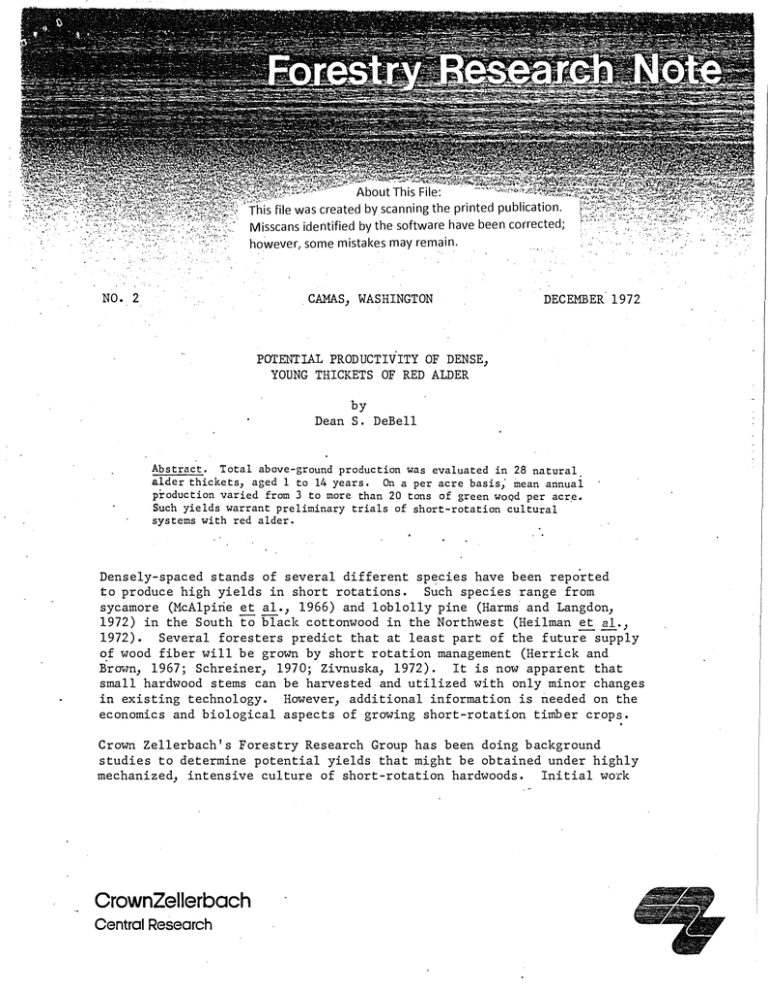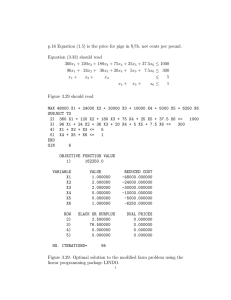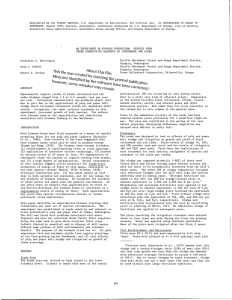Document 12787170
advertisement

About This File: This file was created by scanning the printed publication. Misscans identified by the software have been corrected; ' ,-.. :>. :,,';. however, some mistakes may remain. NO. 2 CAMAS, WASHINGTON DECEMBER 1972 POTENTIAL PRODUCTIVITY OF DENSE, YOUNG THICKETS OF RED ALDER by Dean S. DeBell Abstract. Total above-ground production was evaluated in 28 natural aged 1 to 14 years. On a per acre basis; mean annua production varied from 3 to more than 20 tons of green wOQd per acr,e. alder thickets, i Such yields warrant preliminary trials of short-rotation cultural systems with red alder. Densely-spaced stands of several different species have been reported to produce high yields in short rotations. Such species range from sycamore (McAlpirie et al. , 1966) and loblolly pine (Harms and Langdon, 1972) in the South to black cottonwood in the Northwest (Heilman et al., 1972). Several foresters predict that at least part of the future supply f wood fiber will be grown by short rotation management (Herrick and BrmIn, 1967; Schreiner, 1970; Zivnuska, 1972). It is noW apparent that small hardwood stems can be harvested and utilized with only minor changes in existing technology. However, additional information is needed on the economics and biological aspects of growing short-rotation timber crop . Crown Zellerbach's Forestry Research Group has been doing background studies to determine potential yields that might be obtained under highly mechanized, intensive culture of short-rotation hardwoods. Initial work CrownZellerbach Central Research in cooperation with Washington State University indicated that yields up . to 13 green tons per acre per year were produced by coppiced black cotton­ wood (Heilman et al. , 1972). Although the cottonwood yield? were promis­ ing, Smith (personal communication) suggested that higher yields could be obtained in young stands of dense, red alder. Because of its apparent capacity for such rapid growth in very dense, young stands, red alder seemed a likely candidate for short-rotation management. In order to estimate the potential yield of red alder under intensive culture, we studied the upper limits of productivity in natural alder thickets. Our methods and findings are discussed in this paper. . METHODS Young alder thickets of maximum density were located in the lower Columbia River Valley. Six by six-foot plots were established in the densest clumps within each thicket. Other than density, the only criterion for plot loca­ tion was presence of a border of at least two to three feet of like-spaced trees between the plot and any area which received additional sunlight. This requirement gave some confidence that plot yields· could be reproduced on a per acre basis. All trees on the six by six-foot plot were cut, bundled, and weighed to deter­ mine total green weight for the plot. Total height and root-collar diameter (outside bark) were tallied for each tree. Next, five sample trees .represent­ ing the range in sizes found within the plot were selected for additional measurements. Data were collected from the sample trees to develop relation­ ships of total tree weight or plot weight to weight of stems, branches, and leaves. A disc was cut from the base of each tree for age determinatiorr. Sub-samples of component parts of the trees were collected and evaluated for green weight/oven-dry weight relationships. In addition, two-inch stem sections were collected at root-collar, breast height, and half height for determina­ tions of volume, specific gravity, bark content, and moisture content of stem portions. The data were analyzed by standard multiple regression techniques. RESULTS AND DISCUSSION In total, twenty-eight plots were measured--their characteristics are listed in Table 1. -2- TABLE 1 CHfJU\CTERISTICS OF RED ALDER PLOTS . . Mean Min. Max. Elevation 1000 50 4000 Age (yrs) 6 1 . 14 17 3 46 2.4 0.2 8.2 0.'1/acre) 50 1 243 (ft2/acre) 240 40 . 910 Avg. Dom. Ht. (ft) Avg. Dbh (in. ) No. of Stems Basal Area . ' Tot. Gr. Wt. (tons/acre) 64 3 270 Green :H:A. I. (tons/acre) 8 3 25 The plots were located at elevations ranging fram 50 to 4000 feet above sea level. Average plot age varied from 1 to 14 years. The height of the six tallest dominant trees averaged 17 feet) but varied from 3, to 46 feet. Aver­ age dbh ranged from 0. 2 to 8. 2 inches. The last four characteristics (Table 1) indicate stocking and yield) and are expressed on a per acre basis. Number of stems per acre averaged 50 thousand but range up to 243 thousand. Basal area at the root-collar varied from 40 to more than 900 square feet and averaged 240 square feet. Maximum yield was 25 green tons per acre per year. Regression analyses of several combinations of these plot variables revealed that total plot weight could be predicted accurately from basal area (measured 'at the root-collar) and the average height of the six tallest trees: Plot Green Wt. (lbs) Where Xl = X2 = R2 = 0. 9860 = 2 0. 03327 - 545. 2155 (X1) root-collar basal area avg. ht. of 6 dam. trees SEE (%) = 16% -3­ + 28. 7871 (X1X2) Age was not a significant variable in the regression analysis, primarily because of much variation in yields and densities of stands more than five years old. However, it was' interesting to look at the stocking and growth figures averaged by age class' (Table 2). At age four.? the thickets averaged more than 100 sq. ft. of basal area at the root-collar. While large in­ creases in basal area was occurring, there also was considerable mortality. Apparently, we sampled more productive sites in the 8 to 11 year age class than in the 12 to 14 year age class. TABLE 2 STOCKING .AND GROWTH OF YOUNG RED ALDER . AS RELATED TO AGE CLASS : Age Class -yr:s­ Number of Stems -M­ 1-2 122 46 6 3.7 1.7 . 3-4 60 f09 11 3.8 1.7 5-7 39 213 17 7.1 3.2 8-11 14 715 33 19.3 8".8 12-14 13 440 29 9.8 4.4 Root Collar B.A. -ftL Avg. Dom Height -ft­ , Mean Annual Wood Production Fr. Wt. O.D. Wt. --tons-­ Yields shown were based on the complete tree- -they" include leaves and branches as well as stems. In order to estimate the yield of component parts of the trees, relationships between the parts and total tree weights were evaluated by linear regression. On the average, 74 percent· of total tree weight was contained in the stem, 16 percent in branches, and 10 percent in leaves (Table 3). Because our sampling was done in September) these percentages may not be generally applicable to alder thickets sampled at other times of the year. However, if we exclude leaves and consider only the woody portions, stem and branch weight would amount to 82 percent and 18 percent of the total wood weight) respectively. I' I -4­ TABLE 3 PERCENT COMPOSITION OF YOUNG ALDER TREES CZ Data with Leaves General Values Without Leaves Stems 74 82 Branches 16 18 Leaves 10 - Total 100 100 . Laboratory analyses of stem sections showed that moisture content, bark content, and density of stem wood (expressed on an oven-dry weight basis) were 119 percent, 19 percent, and 27 lbs per cubic foot, respectively. Given this information, We can estimate the volume of stem wood produced on the plots. Cubic foot yields for five of the most productive plots are shown in Table 4. TABLE 4 ESTIMATED ANNUAL PRODUCTION OF STEM WOOD VOLUME ON THE FIVE BEST PLOTS Plot No. Age Productivity Ranking Stem Wood With Bark Without Bark ---ft3/acre--­ 700 .560 25 11 1 20 11 2 660 530 28 13 3 460 370 26 9 4 450 360 5 14 5 390 320 -5- Volume of stem wood including bark produced on these plots ranged from 390 to 700 cubic feet per acre per year. Corresponding values without bark were 320 to 560 cubic feet. Although we sampled plots in age classes from 1 to 14 years, the most productive plots tended to be the oldest ones measured. We were somewhat skeptical of such high yields, and wondered whether they could be'reproduced on a large-scale basis. However, in terms of dry matter production, our highest yields were not out of line with data reported for maximum production achieved by alder and other plant communities in temper­ ate zones. Our study indicated a maximum value of 11. 6 oven-dry tons per acre per year whereas Zavitkovski and Stevens (1972) suggested that above"': ground production might exceed 11 tons per acre per year on better s ites between the ages of 10 and 15 years. Moreover, Westlake's (1963) survey of data on maximum production indicated 13.4 tons per acre per year for total production of temperate perennial crops--an efficiency of about 3%. He also listed 12. 5 tons per acre for coniferous forests and 5.3 tons per acre for deciduous forests. Although our maximum values are much higher than Westlake's figures for deciduous forests, they are comparable to his values for coniferous forests and to Zavitkovski and' Steven's data on red alder. By controlling stand density at early ages, production could probably be increased. The best plots had 1 thousand to 17 thousand stems per acre at 'ages varying from 9 to 14 years. The average stocking for plots of five years and less was 70 thousand stems; therefore, a great deal of mort lity must have occurred on the best plots. Under intensive, short-rotation culture, density would be controlled by initial planting or by early weeding if the land was seeded to alder. Growth could thereby be concentrated on fewer, larger stems. However, work is needed to determine the inter-relationships of age, site productivity; stand density, and yield. Because young alder stems sprout readily after cutting, alder can perhaps be coppiced with several rotations coming from an initial establishment. To sum up, our study of natural thickets indicated that very high yields were achieved in dense, young alder stands. Although additional economic and silvicultural information is needed, it is obvious that red alder is an attractive candidate for intensive culture on short-rotations. -6- LITERATURE CITED 1. Harms, W. R. and O. G. Langdon. 1972. Volume and dry matter yields of loblolly pine grown in dense stands. Abstract in Proceedings of Sixth TAPPI Forest Biology Conference. 2. Heilman, ·P. E. , D. V. Peabody, Jr. , D. S. DeBell and R. F. Strand. (1972). A test of close-spaced, short rotation culture of black cottonwood in the Pac fic Northwest. Canadian Jour. of Forestry Research 2:456-459. 3. Herrick, A. M. and C. L. Brown. lose production: 1967. A new concept in cellu­ silage sycamore. Agr. Sci. Rev. 5 (4) : .. 8-13. 4. McAlpine, R. G. , C. L. Brown, A. M. Herrick, and H. E. Ruark. "Silage" sycamore. Forest Farmer 26 (1): 6-7, 16, illus. 5. Schreiner, E. J. 1970. Mini-rotation forestry. Northeastern Forest Expt. Sta. U.S.D. A. Forest Service Res. Pap. NE-174, 32 pp. 6. Smith, J. H. G. Faculty of Forestry, Vancouver, B. C., Canada. 7. Westlake, D. F. 1963. Review 38;385-425. Zavitkovski, J. and R. D. Stevens. of red alder ecosystems. Ecology. 9. Zivnuska, J. A. 48 (3):126-129. 1972. University of British Columbia, Comparisons of plant productivity. 8. 1966. Bio1. 1972. Primary productivity 53 (2) :235-42. lVhat lies ahead? The Forestry Chronicle





